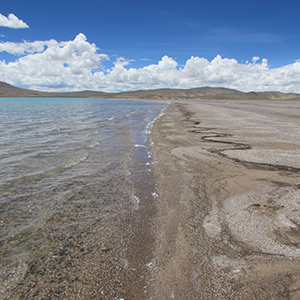Sub-fossil chironomids as indicators of hydrological changes in the shallow and high-altitude lake Shen Co, Tibetan Plateau, over the past two centuries

Accepted: 20 July 2022
Supplementary: 178
HTML: 130
All claims expressed in this article are solely those of the authors and do not necessarily represent those of their affiliated organizations, or those of the publisher, the editors and the reviewers. Any product that may be evaluated in this article or claim that may be made by its manufacturer is not guaranteed or endorsed by the publisher.
Authors
Understanding climate and monsoonal dynamics on the Tibetan Plateau is crucial, as recent hydrological changes, evidenced by rising lake levels, will be accelerated by current global warming and may alter aquatic habitats and species inventories. This study combines chironomid assemblages with sedimentological, mineralogical and geochemical data of a short sediment core (37.5 cm) from the high-altitude (> 4,733 m asl), saline (9 g L-1) and shallow (~5 m water depth) Shen Co, located in the southern part of the central Tibetan Plateau. The predominantly littoral, species-poor (10 chironomid morphotypes) chironomid assemblages are dominated by salt-tolerant taxa, that are highly sensitive to lake level fluctuations and macrophyte vegetation dynamics, making them ideally suited for tracking lake level changes over time. Results indicate a period (from ca. 1830 to 1921 CE) of drier conditions with low runoff and high evaporation rates in the Shen Co catchment, as indicated by a dominance of low-Mg calcite and dolomite and increased Ca/Fe and Sr/Rb ratios. This resulted in a decline in lake levels, an increase in salinity and the periodic occurrence of desiccation events at the sampling site. The first chironomid morphotype to appear after the dry period is Acricotopus indet. morphotype incurvatus, which indicate still low (<2 m) but rising lake levels after 1921 CE due to increasing runoff and a lower evaporation/precipitation ratio, as reflected by coarser grain size, higher quartz content and increased TN, TOC and Al/Si ratios. A replacement of A. indet. morphotype incurvatus by Procladius is observed as lake level rise continued after 1950 CE. The highest lake level is proposed for the period since 2006 CE. From 1955 to 1960 CE and from 2011 to 2018 CE, the presence of the phytophilic taxon Psectrocladius sordidellus-type supported abundant macrophyte growth. These changes are consistent with climate reconstructions from the northern and central Tibetan Plateau, indicating warmer and wetter climate conditions since the beginning of the 20th century, which have led to an increase in lake level in a number of Tibetan lakes. Our study specifically highlights 1920 and 1950 as years with enhanced precipitation. This can be attributed to the strong, with overlapping multidecadal cycles of Westerlies and monsoon systems. This study demonstrates the significance of studying small, shallow lakes, as they frequently contain aquatic communities that respond more rapidly to the changes in the lake system. In addition, this study expands our understanding of the ecology of Tibetan chironomid morphotypes, highlighting this group’s potential as paleolimnological proxies for investigating past environmental and climatic changes.
Edited by
Diego Fontaneto, CNR-IRSA Water Research Institute, Verbania, ItalySupporting Agencies
Nam Co Observation and Research Station (NAMORS), International Research Training Group, Deutsche Forschungsgemeinschaft (DFG grant 317513741 / GRK 2309), Open Access Publication Funds of the Technische Universität BraunschweigHow to Cite

This work is licensed under a Creative Commons Attribution-NonCommercial 4.0 International License.
Similar Articles
- Jong-Yun Choi, Kwang-Seuk Jeong, Geung-Hwan La, Gea-Jae Joo, Spatio-temporal distribution of Diaphanosoma brachyurum (Cladocera: Sididae) in freshwater reservoir ecosystems: importance of maximum water depth and macrophyte beds for avoidance of fish predation , Journal of Limnology: Vol. 74 No. 2 (2015)
- Markus A. Hoffmann, Alberto Benavent González, Uta Raeder, Arnulf Melzer, Experimental weed control of Najas marina ssp. intermedia and Elodea nuttallii in lakes using biodegradable jute matting , Journal of Limnology: Vol. 72 No. 3 (2013)
- Simona Musazzi, Martina Austoni, Aldo Marchetto, A georeferenced dataset of living and sedimentary diatoms in Lake Maggiore , Journal of Limnology: Vol. 82 No. s1 (2023): Georeferenced freshwater biodiversity data
- Roberta Bettinetti, Letizia Garibaldi, Barbara Leoni, Silvia Quadroni, Silvana Galassi, Zooplankton as an early warning system of persistent organic pollutants contamination in a deep lake (lake Iseo, Northern Italy) , Journal of Limnology: Vol. 71 No. 2 (2012)
- Marta Bolgan, Emilia Chorazyczewska, Ian J. Winfield, Antonio Codarin, Joanne O'Brien, Martin Gammell, First observations of anthropogenic underwater noise in a large multi-use lake , Journal of Limnology: Vol. 75 No. 3 (2016)
- Massimo Morpurgo, Peter Schuchert, Samuel Vorhauser, Renate Alber, Occurrence of two distinct lineages of the freshwater jellyfish Craspedacusta sowerbii (Hydrozoa: Limnomedusae) in Italy , Journal of Limnology: Vol. 80 No. 1 (2021)
- Yimy Herrera-Martínez, Juan César Paggi, Camilo Bernardo García, Cascading effect of exotic fish fry on plankton community in a tropical Andean high mountain lake: a mesocosm experiment , Journal of Limnology: Vol. 76 No. 2 (2017)
- Jacek Radzikowski, Anna Sikora, Mirosław Ślusarczyk, The effect of lake sediment on the hatching success of Daphnia ephippial eggs , Journal of Limnology: Vol. 75 No. 3 (2016)
- Thaisa S. Michelan, Márcio J. Silveira, Danielle K. Petsch, Gisele D. Pinha, Sidinei M. Thomaz, The invasive aquatic macrophyte Hydrilla verticillata facilitates the establishment of the invasive mussel Limnoperna fortunei in Neotropical reservoirs , Journal of Limnology: Vol. 73 No. 3 (2014)
- Sonia Endrizzi, Maria Cristina Bruno, Bruno Maiolini, Distribution and biometry of native and alien crayfish in Trentino (Italian Alps) , Journal of Limnology: Vol. 72 No. 2 (2013)
<< < 16 17 18 19 20 21 22 23 24 25 > >>
You may also start an advanced similarity search for this article.
-
Paula Echeverría‐Galindo, Sonja Rigterink, Julieta Massaferro, Liseth Pérez, Bernd Wünnemann, Philipp Hoelzmann, Wengang Kang, Nicole Börner, Anja Schwarz, Andreas Laug, Ping Peng, Junbo Wang, Liping Zhu, Antje SchwalbJournal of Quaternary Science : 2023
-
Marco Bertoli, Gianguido Salvi, Rachele Morsanuto, Elena Pavoni, Paolo Pastorino, Giuseppe Esposito, Damià Barceló, Marino Prearo, Elisabetta PizzulDiversity : 2024

 https://doi.org/10.4081/jlimnol.2022.2077
https://doi.org/10.4081/jlimnol.2022.2077





